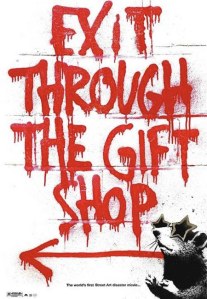…
Exit Through the Gift Shop is, ostensibly, a documentary about the rising phenomenon of street art—and, in particular, the street art of the mysterious Banksy. At least, that’s how the film begins; where it ends is, in fact, in a much different place. Rather than the story of the notoriously secretive Banksy, we instead get the story of a strange French immigrant named Thierry Guetta, who, since the death of his mother when he was a child (at least as the story goes) has been obsessed with filming every minute of his waking life. The camera, as he and his friends and family explain, goes with him everywhere; the finished tapes fill boxes upon boxes in his home, though never to be watched, or even properly labelled. We learn that Guetta originally made his living selling clothing, not as a filmmaker…but this all changed when he found his purpose in the street art movement.
Thanks to a familial connection to a street artist named Space Invader, Guetta became involved with the movement early on, and started accompanying (and filming) not only his cousin, but a whole host of up-and-coming street artists. He not only recorded their “vandalism,” but participated in it, going so far as to follow the artists onto rooftops and into other dangerous places. Still, Guetta was content simply to film; despite giving his subjects the vague impression that one day all of this filming would culminate in a documentary, he had no plans for the footage to wind up anywhere besides his boxes of tapes. This was all before he met Banksy.
At least in the film, the relationship between Banksy and Guetta seems almost fated. It was, after all, Banksy’s influence that galvanized Guetta to become more than simply the passive recorder of life events. Banksy inspired Guetta to not only film art, but make art. At first, this was in the form of that long-promised documentary on street art. However, upon discovering that Guetta is perhaps the worst filmmaker ever to have lived, Banksy redirected his energies toward creating actual artworks. Guetta rechristened himself Mr. Brainwash, and set about putting together his own art show. Significantly, he did not create any of the works himself, but developed the ideas that his extensive staff executed. Much to Banksy’s, and artist Shepard Fairey’s, chagrin, Mr. Brainwash, or MBW, was an overnight success, and quickly starting selling his work to serious collectors.
Interviews with the two artists reveal a disdain for both Mr. Brainwash’s method and his actual derivative artistic style. Banksy argues that MBW’s “art” essentially renders art meaningless, in that it is created for an aesthetic purpose over a message. Additionally, MBW has no artistic background, or even ability. He has adopted street art as a medium without actually having created much art on the streets. The film asks its viewers to consider the very nature of art, particularly that which is created as a transgressive act. What does it mean when street art begins to sell for thousands of dollars at auctions? What, truly, is the difference between Mr. Brainwash, the kooky French dilettante who achieves success through hype and style, and Banksy, the consummate artist? Once both of them become associated with the same artistic movement, and attract the attention of art collectors, does it really matter who is authentic and who is an interloper? Perhaps Mr. Brainwash commits the most transgressive act of all.
This is, essentially, the conundrum of the film: What is “legitimate” and what is not? Can street art, with its intentional illegitimacy (or, at least, illegality), be judged by any set criteria without risking a total misrepresentation of its purpose? Indeed, the whole story of Thierry Guetta seems to serve as an allegory for the impossibility of “true” street art. If someone like Mr. Brainwash, whom we have seen in all his incompetent glory, can become an overnight success, then what does this mean for the movement? Is there even a movement at all?
One underlying possibility, which occasionally pops up in reviews for the film, is that the entire documentary aspect is a farce. That is, there is no Thierry Guetta, or Mr. Brainwash—or, at least, not as we see him in the film. There is certainly some evidence to support this, namely that so much of Guetta plays as caricature. We are essentially laughing at this man, who produces an entire film completely composed of fast MTV-style cuts, and, upon injuring his foot, is carted around in a wheelbarrow. Some have speculated that Guetta is part of a giant hoax perpetrated by Banksy himself. But, if that is the case, then Banksy is even more dedicated than we all thought. The events in the film—Mr. Brainwash’s art show in 2008, for example—have been confirmed to be true. Thus, Mr. Brainwash can technically boast a real, documented history…but does that necessarily mean that he himself, that man in the wheelbarrow, is real? Ultimately, we cannot say, we cannot know, for he is just as nebulous as the true purpose of street art. Is it a joke or is there a deeper meaning? In the end, does it really matter? All in all, Exit Through the Gift Shop is a fascinating exploration of what it means to make art. The fact that the art, in this case, so challenges our concept of reality is perhaps the most interesting lesson of all.



